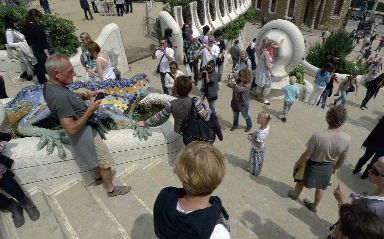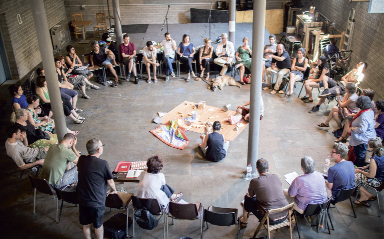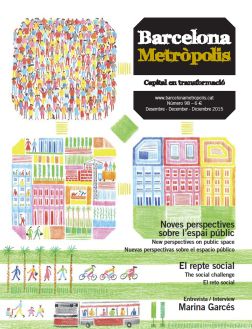
One of the different examples of uses of public space: tourists in Park Güell.
Photo: Vicente Zambrano
The debate about public space in the city is just as lively as ever, or maybe even more so. Ultimately, it is about finding collective solutions where the public and the authorities work together. Making a city from people.
People can be found in public spaces more than in their own homes. This was the surprising discovery made by Ana María Dávila, a Chilean journalist, when she arrived in Barcelona in the early 1980s. As she herself explains in the section “Visions of Barcelona”, she had landed in a public space that was still that of pre-Olympics Barcelona, with large areas yet to be developed and transformed.
Now, forty years later, the debate about public space in the city is just as lively as ever, or maybe even more so. This is because the city remains alive and unfinished, with spaces that every so often require rethinking in order to be inhabited, travelled, worked and shared in a thousand different ways, in line with social changes and the new needs of the citizens that live there and make them their own.
The city has changed – hugely – and great urban development work has been done, from reclaiming the seafront between the Besòs and Llobregat rivers to building ring roads, as well as recovering entire neighbourhoods such as Poblenou or building new ones such as Diagonal Mar and Vila Olímpica. However, there are still big projects on the table, such as the work on La Sagrera railway station, which also involves the unfinished number 9 metro line; the reorganisation of Plaça de les Glòries and its surroundings; and the redevelopment of the Marina del Prat Vermell neighbourhood, to name just a few examples.
Although it is often major projects that come to mind when we think about urban development, public space is also made up of the network of small or large roads, courtyards, alleyways, parks and gardens, communal elements within residents’ communities, as well as the fabric of open public amenities: markets, civic centres, libraries, museums, art factories and centres… Homes fit in between large infrastructures
and these other spaces for passing through and participating in. Town planners and architects are thus facing the dilemma of responding to both individual and collective needs, public and private needs, and setting different limits and definitions of what stays within and outside the public space.
This issue of Barcelona Metròpolis brings together a group of architects and town planners who analyse the public space of the four areas where everyday life takes place: the home, transport, work, and leisure, culture and participation. The authors of this dossier suggest responding to the needs in these four areas by putting people at the centre, looking at the city from street level and making the most of empty spaces to provide settings where the public can participate, get involved and play the leading role.

One of the different examples of uses of public space: a meeting of La Borda social housing cooperative at Can Batlló.
Photo: La Borda
The proposals gathered here include innovative and alternative ideas, such as those emerging from the solidarity economy, broad-based participation and counter-culture, as well as fields of experimentation that allow for new ways of participating. Town planners and architects are calling for close cooperation between civil society and public authorities, and agree on the need to promote more public housing and fewer private vehicles. This housing now accounts for 1.6% of the total housing stock available, either to buy or to rent. Cars, meanwhile, occupy 60% of the available public space, when only 15% of trips are made with this kind of transport.
Ultimately, it is about finding collective solutions where the public and the authorities work together. Twenty-five years ago, Manuel de Solà-Morales predicted that collective space (and we are not just talking about public space) would form the future wealth of cities. These proposals therefore suggest building the city and its public space so that they will organise community life and at the same time be personally welcoming, both for the people born there as well as for visitors. This is the case of refugee writer Basem Al-Nabriss , who closes the magazine with a collection of short stories about Barcelona written during his stay as Catalan PEN’s “Writer in Refuge”. Making a city from people.



